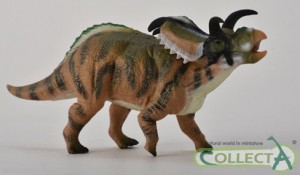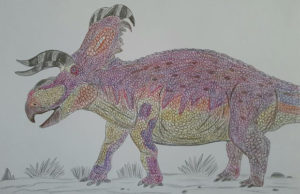Discovery of New Horned Dinosaur from Montana
Huge Chasmosaurine Medusaceratops lokii a Montana Dinosaur Mystery
Scientists at the Cleveland Museum of Natural History have announced the discovery of a new genus of horned dinosaur (Ceratopsian) from Late Cretaceous sediments in Montana. This new dinosaur, that roamed this part of the United States in herds, approximately 78 million years ago, is estimated to have exceeded 6 metres in length and weighed over 2 tonnes. This new prehistoric animal, a member of the same group of horned dinosaurs (Chasmosaurine) as Pentaceratops and Triceratops, has been named Medusaceratops lokii, the genus name relating to the flamboyant crest with numerous epoccipitals (lumps, bumps, and horns around the head crest), resembling the fearsome snake covered head of Medusa from Greek legend. The species name is in deference to the Norse God of mischief – Loki, as when fossils of this dinosaur were first discovered it confused scientists as to whether is was a member of the chamosaurine or centrosaurines (two sub-groups of ceratopsians).
A Model of the Newly Described Dinosaur Medusaceratops

Named after the Greek Gorgon Medusa who had snakes for hair. A CollectA Medusaceratops dinosaur model.
The image (above) shows a replica from the CollectA Prehistoric Life model range: CollectA Age of Dinosaurs Prehistoric Life Models.
Horned Dinosaur
The announcement was made by the distinguished scientist and dinosaur expert Dr Michael J Ryan, who is based at the Cleveland Museum of Natural History (Ohio,United States). The fossils of this new ornithischian ceratopsid have been dated to the Campanian faunal stage of the Cretaceous.
Dr Ryan, the curator and head of Vertebrate Palaeontology at the Cleveland museum has published his findings as lead author of a new book on North American horned dinosaurs; “New Perspectives on Horned Dinosaurs: The Royal Tyrrell Museum Ceratopsian Symposium”.
We at Everything Dinosaur, have had the pleasure of reading a number of DrcRyan’s publications, as we sit here checking this article, a copy of “Dinosaur Provincial Park”, a volume on the ancient ecosystem of Alberta, Canada, is on a shelf in front of us. DrcRyan was a contributor to this publication and many of the chapters written about Dinosauria contain references to his published work.
Medusaceratops belongs to the Chasmosaurinae subfamily of the horned dinosaur family Ceratopsidae. The other subfamily is Centrosaurinae. The specimen is the first Campanian-aged chasmosaurine ceratopsian found in Montana. It is also the oldest known chasmosaurine ceratopsian known to science
Fossils of Medusaceratops were discovered in a bonebed on private land adjacent to the Milk river in north, central Montana. Fossils and other material was acquired by Canada Fossil Inc. (Calgary, Alberta) in mid 1990s. The company consulted Dr Ryan and his colleagues about the fossils, but at first the scientists were unable to make a positive identification.
Medusaceratops had giant brow bones more than 3 feet long over each eye, and a large, shield-like frill off the back of its skull adorned with large curling hooks. Medusaceratops lokii means “Loki’s horned-faced Medusa,” referring to the thickened, fossilised, snake-like hooks on the side of the frill (the epoccipitals).
Commenting on this discovery, Dr Ryan stated:
“At first we could not figure out what we had. Some of the material looked as if it came from a form related to Centrosaurus [centrosaurine ceratopsian, like Pachyrhinosaurus or Achelousaurus] a centrosaurine noted for having short brow horns. The rest of the pieces had giant brow horns similar to Triceratops [Chasmosaurine]. That’s one of the problems with bonebeds – even though you can collect a large amount of material, much of it is broken and all of it is disarticulated, so the story is rarely clear cut.”
Eventually Dr Ryan found a complete articulated skull of a centrosaur with long brow horns in southern Alberta of what appeared to be the new animal from Montana, and named it Albertaceratops in 2007. At that time, he assumed he was looking at a stray that had literally crossed the international border between what was to become Canada and the United States.
To read an article on the discovery of Albertaceratops: “Alberta Horned Face” – An Ancestor of Triceratops.
Medusaceratops lokii
After re-examining the material from Montana, Dr Ryan realised that at least some of the material in the Montana bonebed was not Albertaceratops. Some of the elements were much larger than any other horned dinosaur from the same time period, including Albertaceratops. Even though Albertaceratops and Medusaceratops are superficially very similar, the shape and number of the hooks and ornaments along the edge of the frill actually puts them in separate horned dinosaur groups, with Medusaceratops being a chasmosaur and Albertaceratops a centrosaurine.
Commenting on the huge frill on Medusaceratops, Dr Anthony Russell, Professor of Biological Sciences at the University of Calgary (Alberta) stated:
“Although the ornamentation on the frill is pretty spectacular, it probably was not used for defence against predators, rather it was more likely prehistoric “bling” used to attract a mate.”
The descriptive terms, used to distinguish centrosaurines from chasmosaurines are often not adequate to permit a genus to be ascribed to the appropriate subfamily of ceratopsians. For example, the centrosaurines are often referred to as “short-frilled” dinosaurs, with large nose horns, often bigger than any brow horns, if brow horns were present. In contrast, the chasmosaurines are known as “long-frilled” dinosaurs with large, neck frills and long snouts. The brow horns are usually much bigger than any nose horn, if a nose horn was present.
An Illustration of Medusaceratops
Dr Ryan said:
“Medusaceratops is the oldest member of the Chasmosaurinae in North America and shows that the group, like its most famous member, Triceratops, had long brow horns and were fairly large when they first evolved. Later chasmosaurs that are just a bit younger [found in later strata], tend to have much shorter horns and have much lighter, smaller bodies.”
If this large, herbivore evolved large brow horns to fend off the attacks from predatory dinosaurs, then this poses an intriguing question for the scientists. What types of really big predatory dinosaurs shared this environment with Medusaceratops?
A number of tyrannosaurid genera are known from the western part of North America (Campanian faunal stage), perhaps awaiting discovery are the fossils of a large carnivore bigger than Daspletosaurus or Gorgosaurus.
Dr Ryan said:
“Here we have something almost the size of Triceratops, but 10 million years before it lived. T. rex was not around yet, so what was Medusaceratops squaring off against? That’s one of the things we’re looking for in Alberta.”
The research was originally conducted when Michael Ryan was a Ph.D. candidate working with Dr Russell at the University of Calgary in Alberta, Canada. Much of the material, including the holotype, is now in the collection of the Wyoming Dinosaur Centre in Thermopolis, Wyoming (USA), with other material curated at the Royal Tyrrell Museum in Drumheller, Alberta (Canada).


